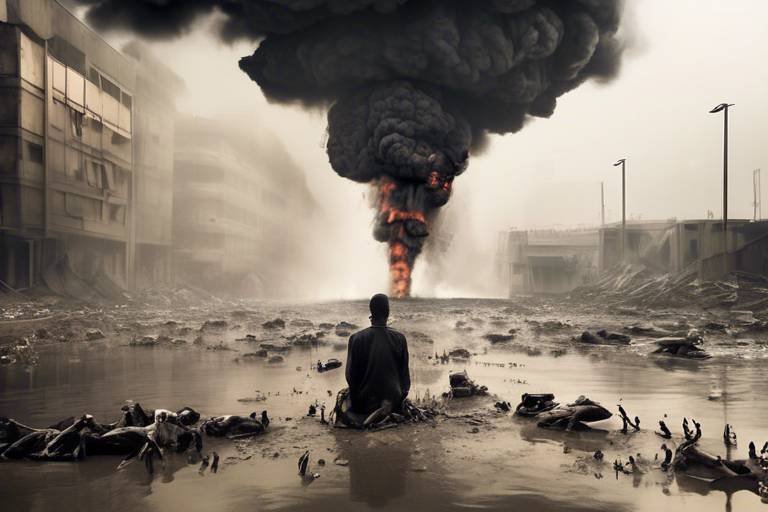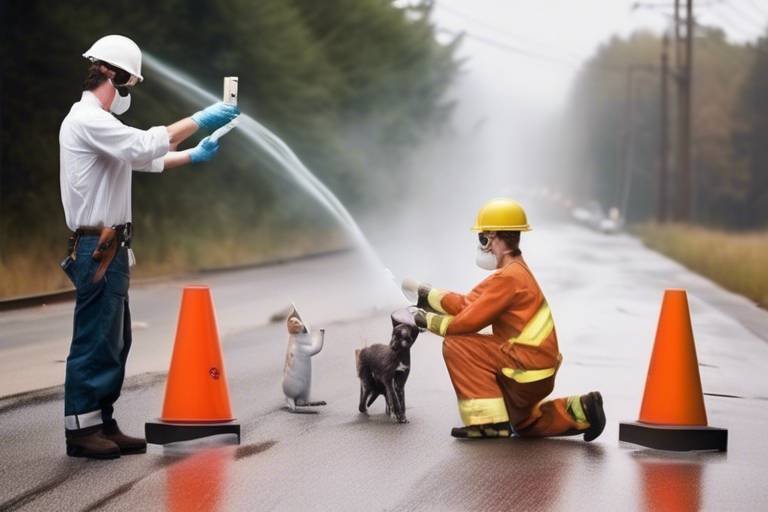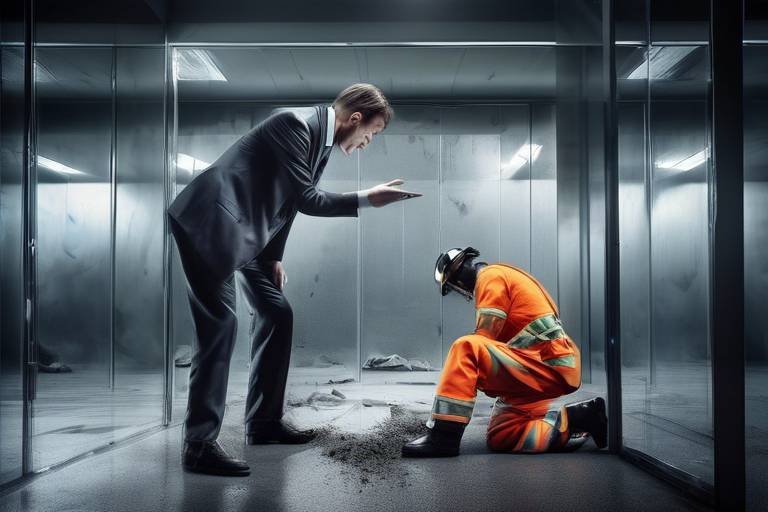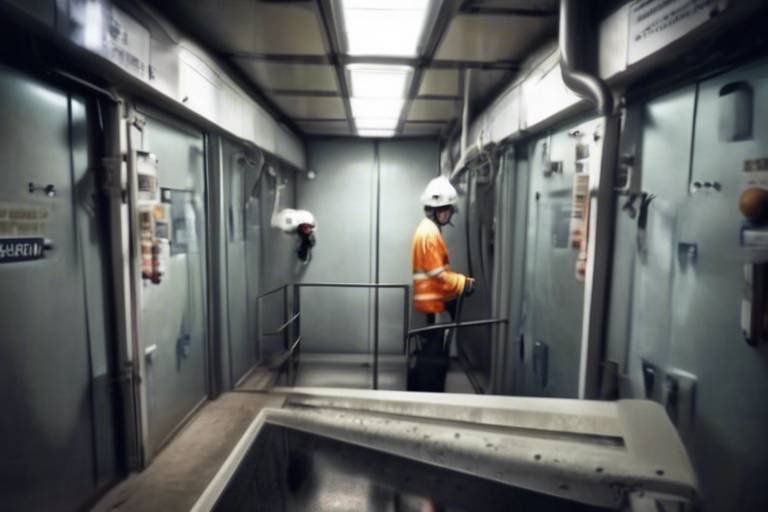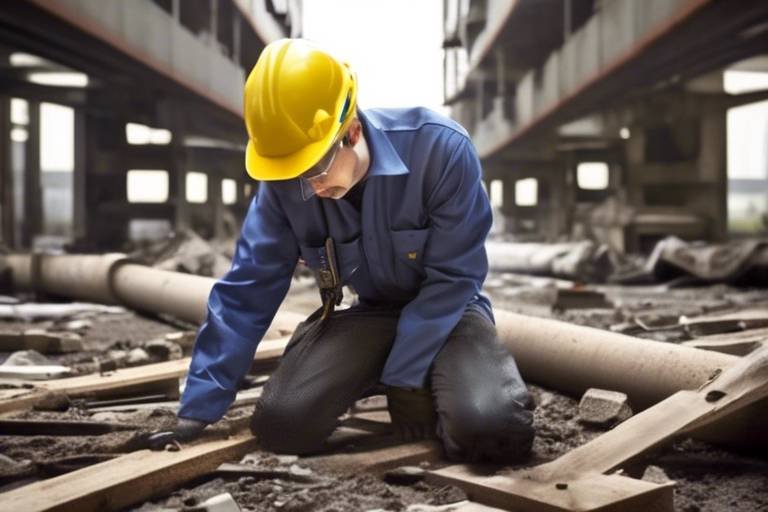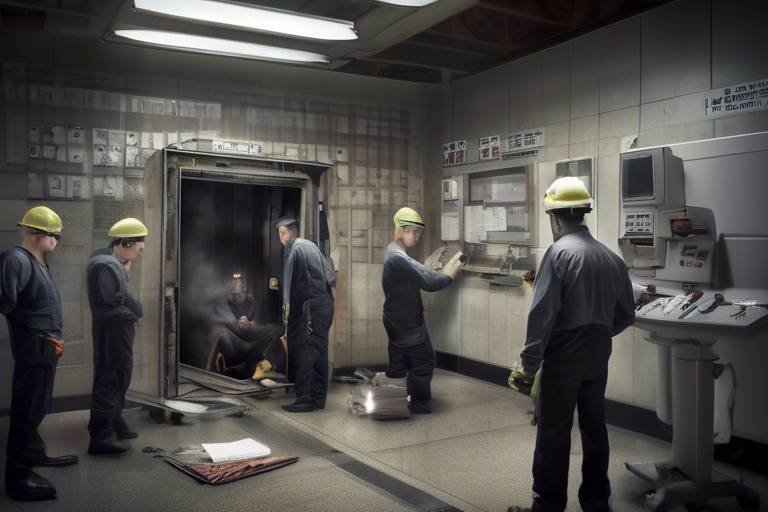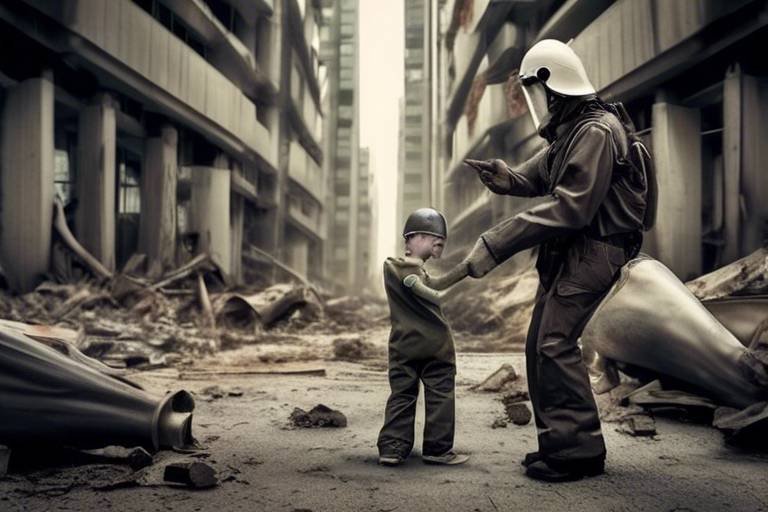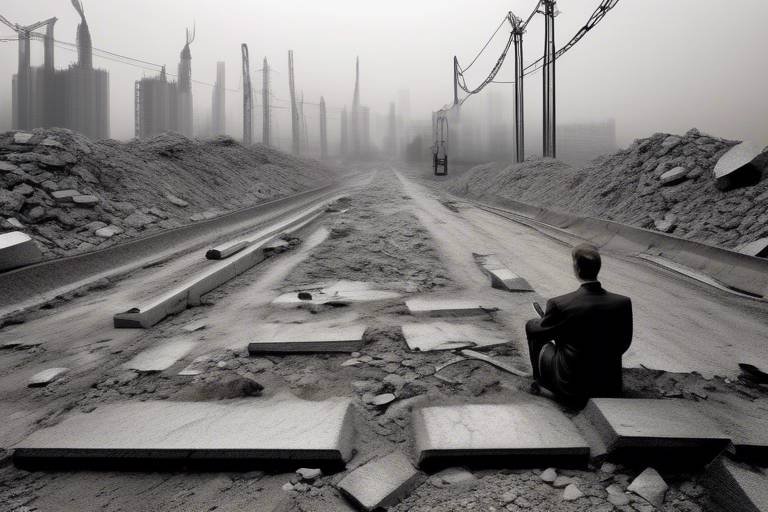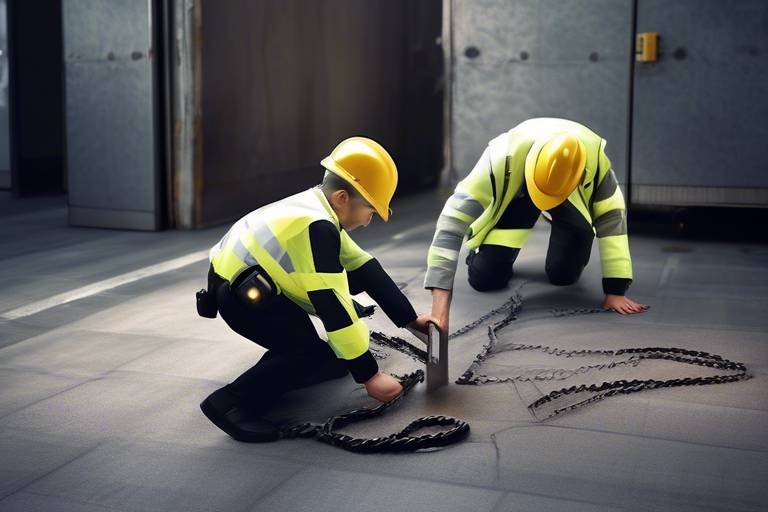Can Understanding Human Behavior Pave the Way to Safer Environments?
In a world where safety is paramount, the question arises: can we truly create safer environments by understanding human behavior? The answer is a resounding yes! By delving into the intricacies of how people think, feel, and act, we can craft spaces that not only protect but also empower individuals to make safer choices. Imagine walking into a public space designed with an acute awareness of human psychology—where every element, from lighting to signage, is strategically placed to guide behavior towards safety. This article takes you on a journey through the fascinating intersection of psychology and safety, revealing how insights into human behavior can lead to environments that are not just safe, but also conducive to well-being.
Understanding how individuals perceive and assess risks is crucial for creating safer environments. Risk is not just a statistic; it's a subjective experience shaped by various psychological factors. For instance, consider how people often underestimate the dangers of familiar surroundings while overestimating risks in unfamiliar situations. This cognitive bias can lead to dangerous decisions, especially in emergency contexts. By recognizing these patterns, safety designers can implement strategies that enhance risk awareness. For example, incorporating educational signage that highlights potential hazards can recalibrate perceptions and encourage more cautious behavior.
When the unexpected happens, human behavior often follows predictable patterns. In emergency situations, individuals may react with panic, indecision, or even heroism. Understanding these responses can be instrumental in developing effective safety protocols. For instance, during a fire alarm, people might freeze or attempt to gather belongings instead of evacuating promptly. By studying these common reactions, safety trainers can create simulations that prepare individuals to respond appropriately. This proactive approach not only saves lives but also fosters a culture of preparedness.
The behavior of individuals in groups can significantly impact safety outcomes. During crises, group dynamics can lead to both positive and negative behaviors. For example, in a chaotic situation, individuals may look to others for cues on how to react, which can either facilitate a swift evacuation or cause confusion. Understanding these dynamics allows for the creation of better training programs that emphasize the importance of clear communication and leadership during emergencies.
Effective leadership plays a vital role in guiding group behavior during crises. Strong leaders can instill confidence and provide direction, which is crucial in high-stress situations. They serve as anchors, helping individuals focus on safety rather than panic. Training leaders in crisis management can enhance overall group responses, making environments safer for everyone involved.
Peer pressure and social norms can shape individual actions in emergencies. When individuals see others reacting calmly and decisively, they are more likely to follow suit. This phenomenon highlights the importance of fostering a culture of safety where positive behaviors are modeled and encouraged. Safety campaigns that leverage social influence can effectively promote safer practices within communities.
People respond differently to threats based on personality traits and past experiences. Some may leap into action, while others might hesitate. By recognizing these individual differences, safety protocols can be personalized to cater to various responses. For instance, training programs can be tailored to address specific personality types, ensuring that everyone feels equipped to handle emergencies in their unique way.
Environmental design can significantly influence human behavior. By integrating psychological principles into design, we can create public spaces and workplaces that inherently promote safety. Think of it like setting the stage for a play—every element must work harmoniously to guide the audience's experience. Similarly, environments can be designed to encourage safe behaviors through thoughtful layout, color schemes, and accessibility. For example, bright, clear signage can direct individuals towards exits, while open spaces can reduce feelings of claustrophobia, ultimately leading to safer outcomes.
Visual and auditory cues can guide behavior in environments. Strategic placement of signs, alarms, and even the use of color can enhance safety awareness. For instance, using red for warning signs taps into our instinctual recognition of danger. Moreover, auditory signals, such as alarms or announcements, can prompt immediate action, ensuring that individuals remain alert and responsive to potential threats.
Advancements in technology offer innovative solutions for safety. From smartphone apps that provide real-time alerts to smart devices that monitor environmental conditions, technology can significantly influence human behavior towards safer practices. Imagine an app that notifies you of potential hazards in your vicinity or a smart building that adjusts lighting and temperature to optimize comfort and safety. These tools not only enhance awareness but also empower individuals to take proactive steps in ensuring their own safety.
Education plays a key role in shaping behavior related to safety. By equipping individuals with knowledge and skills, we can foster a culture of preparedness. Effective training methods that promote awareness and preparedness in various environments are essential. Engaging individuals in realistic simulations and role-playing exercises can significantly enhance their responses to emergencies, making them feel more confident and capable when faced with real-life situations.
Engaging individuals in realistic simulations can enhance their responses to emergencies. Role-playing exercises allow participants to experience scenarios in a safe environment, enabling them to practice decision-making and develop critical thinking skills. This hands-on approach not only makes the training memorable but also instills a sense of confidence that can be invaluable during an actual crisis.
Involving communities in safety education fosters collective responsibility. Community programs that promote safety awareness can significantly impact behaviors and attitudes towards safety. By working together, communities can create a network of support that enhances safety for all. Initiatives such as neighborhood watch programs or community drills not only prepare individuals but also strengthen bonds among community members, making everyone feel more secure.
- How does understanding human behavior improve safety? Understanding human behavior allows for the design of environments and protocols that align with natural responses, leading to safer outcomes.
- What role does technology play in enhancing safety? Technology provides tools and solutions that enhance awareness and prompt proactive safety measures.
- Why is community engagement important for safety? Community engagement fosters collective responsibility and support, making safety a shared priority.

The Psychology of Risk Assessment
Understanding how individuals perceive and assess risks is crucial for creating safer environments. It’s fascinating to consider how the human mind works when confronted with potential dangers. Have you ever noticed how some people seem to thrive in risky situations while others shy away? This divergence in behavior often stems from a complex interplay of psychological factors, including past experiences, cultural influences, and innate personality traits. For instance, individuals who have experienced a traumatic event may be more risk-averse, constantly weighing the potential dangers against the benefits of any action they consider. On the other hand, thrill-seekers often embrace risk, driven by the adrenaline rush that comes with uncertainty.
One significant aspect of risk assessment is the concept of cognitive bias. Cognitive biases are systematic patterns of deviation from norm or rationality in judgment, which can significantly influence decision-making processes. For example, the optimism bias leads individuals to believe that they are less likely to experience a negative event compared to others. This can result in underestimating risks and, consequently, neglecting necessary safety precautions. Conversely, the availability heuristic can cause people to overestimate the likelihood of dramatic events, such as plane crashes, simply because they are more memorable or widely reported in the media.
Moreover, the framing effect plays a pivotal role in how risks are perceived. The way information is presented can alter an individual's decision-making process. For instance, if a safety campaign emphasizes that "90% of people survive a particular emergency," it might instill a sense of confidence. However, if the same campaign states that "10% of people do not survive," it could evoke fear and anxiety. Understanding these psychological nuances is essential for developing effective safety messages and protocols.
To illustrate further, let’s consider a
| Cognitive Bias | Description | Impact on Risk Assessment |
|---|---|---|
| Optimism Bias | Belief that one is less likely to experience a negative event than others. | Underestimation of risks, leading to complacency. |
| Availability Heuristic | Overestimating the likelihood of events based on how easily examples come to mind. | Heightened fear of rare events, neglecting more probable risks. |
| Framing Effect | The way information is presented affects decision-making. | Influences perception of risk based on wording. |
By recognizing these biases, safety professionals can tailor their approaches to better resonate with individuals’ perceptions of risk. For example, safety training that acknowledges these biases can help participants understand their own thought processes and make more informed decisions in emergency situations.
In addition to cognitive biases, social factors also play a significant role in risk assessment. The influence of peers can sway an individual’s perception of risk, often leading them to take risks they might otherwise avoid. This social dynamic can be particularly evident in group settings, where the desire to conform can override personal judgments. Understanding these social influences is vital for creating comprehensive safety strategies that account for both individual and group behaviors.
In conclusion, the psychology of risk assessment is a multifaceted area that intertwines cognitive biases, social influences, and personal experiences. By delving deeper into these psychological patterns, we can develop more effective safety measures that not only address the risks but also resonate with individuals on a personal level. As we continue to explore this relationship, it becomes increasingly clear that understanding human behavior is not just beneficial but essential for fostering safer environments.

Behavioral Patterns in Emergency Situations
When the unexpected strikes, human behavior can often be as unpredictable as the events themselves. During emergencies, our instincts kick in, and surprisingly, many of our reactions follow recognizable patterns. Understanding these patterns can be the key to improving safety protocols and training programs. For instance, in the face of a fire alarm, how many of us have seen people freeze in place, unsure whether to evacuate or stay put? This hesitation can be a critical factor in emergency response.
Research shows that during crises, individuals tend to exhibit a range of behaviors that can be categorized into a few common responses. These include flight, where people instinctively seek to escape; fight, where individuals confront the threat; and freeze, where they become paralyzed by fear. Each of these responses has its own implications for safety management. For example, in a crowded space, the flight response can lead to chaos if not managed properly, while the freeze response can hinder timely evacuations.
Moreover, understanding the psychological triggers that lead to these behaviors is essential. Stress and panic can cloud judgment, leading to poor decision-making. For instance, during a natural disaster, individuals might overlook clear evacuation routes because their minds are racing with fear. This can be exacerbated by the presence of others; when one person panics, it can create a ripple effect, causing a larger group to react similarly. This phenomenon is often referred to as contagion behavior, and it highlights the importance of clear communication and leadership during emergencies.
The behavior of individuals in groups can significantly impact safety outcomes. When an emergency occurs, the dynamics within a group can either facilitate a smooth evacuation or lead to confusion and chaos. For example, if a leader remains calm and directs others effectively, the group is more likely to respond in an organized manner. On the other hand, if panic spreads, the collective response can become disjointed. This is why understanding group psychology is so vital in emergency planning.
Effective leadership during a crisis can be the difference between safety and disaster. A strong leader can instill confidence and provide clear instructions, guiding individuals through the chaos. This leadership isn't just about authority; it's about influence. People look to leaders for cues on how to react, and a calm, collected demeanor can help to mitigate panic. In fact, studies have shown that groups with strong leadership are significantly more likely to follow safety protocols during emergencies.
Peer pressure and social norms play a crucial role in shaping individual actions during emergencies. When people see others evacuating, they are more likely to follow suit, even if they initially hesitated. This is where understanding social influence becomes a powerful tool for safety strategies. By creating an environment where safety behaviors are the norm, organizations can enhance the likelihood of a positive response during emergencies. For instance, regular safety drills can help establish these norms, making it second nature for individuals to act swiftly when it counts.
In summary, the behavioral patterns observed during emergencies are not just random reactions; they are predictable responses shaped by psychological factors and social dynamics. By studying these patterns, we can develop better safety protocols that not only account for individual behaviors but also leverage group dynamics to create a safer environment for everyone involved.
- What are the common behaviors exhibited during emergencies?
Common behaviors include flight, fight, and freeze responses. Understanding these can help in developing effective safety protocols. - How does group dynamics affect emergency responses?
Group dynamics can either facilitate or hinder effective responses during crises. Strong leadership and clear communication are key. - What role does social influence play in emergencies?
Social influence can significantly impact individual behaviors. When people observe others taking action, they are more likely to follow that example.

Group Dynamics in Crises
When a crisis hits, it’s fascinating to observe how individuals behave within a group. The dynamics that unfold can often be a rollercoaster of emotions and actions, revealing a lot about human nature. In high-pressure situations, people tend to look to one another for cues on how to respond. This social influence can lead to a range of outcomes, from panic to cooperation. Have you ever noticed how during a fire drill, some people remain calm while others rush for the exits? This is a classic example of how group dynamics can shape behavior in critical moments.
During emergencies, individuals often seek the safety and comfort of their peers. This can lead to a phenomenon known as herd behavior, where the actions of a few can influence the many. For instance, if one person decides to run, others might follow suit without fully assessing the situation. This can create a chaotic environment, making it even more challenging to manage the crisis effectively. Understanding these patterns is crucial for developing effective safety protocols. By analyzing past incidents, researchers have identified several common behaviors that emerge in group settings during emergencies:
- Panic Response: Often, when the threat is perceived as immediate, panic can spread quickly, leading to irrational decisions.
- Conformity: Individuals may conform to the behavior of the majority, even if it’s not the safest choice.
- Leadership Emergence: In crises, certain individuals naturally step up to lead, which can either stabilize or complicate the situation.
These behaviors highlight the importance of preparing individuals not just as isolated entities, but as members of a group. Training programs should incorporate scenarios that simulate group dynamics, allowing participants to experience and understand how their actions can influence others. For example, role-playing exercises can help participants recognize the importance of maintaining composure and making informed decisions rather than succumbing to panic.
Moreover, the role of leadership cannot be overstated. Effective leaders can guide a group through a crisis by instilling confidence and providing clear instructions. When individuals feel secure in their leader’s capabilities, they are more likely to follow directions and work together towards a common goal. This is where strong communication skills come into play. Leaders who can articulate a plan of action and reassure their group can significantly improve safety outcomes.
In summary, understanding group dynamics in crises is essential for enhancing safety protocols. By recognizing how individuals interact under pressure, we can develop training programs and safety measures that account for these behaviors. Ultimately, fostering a culture of preparedness and cooperation can lead to more positive outcomes when emergencies arise.
- What are group dynamics in a crisis? Group dynamics refer to the behaviors and psychological processes that occur when individuals interact in a group during a crisis.
- How can understanding group dynamics improve safety? By recognizing common behaviors and responses in groups, safety protocols can be tailored to mitigate panic and promote effective communication.
- What role does leadership play in group dynamics during crises? Effective leadership can guide group behavior, instill confidence, and provide clear instructions, which are crucial for navigating emergencies.

Leadership and Influence
In times of crisis, effective leadership can be the difference between chaos and order. When the unexpected strikes, people often look to leaders for guidance, reassurance, and direction. This is where the true essence of leadership shines—it's not just about making decisions; it’s about influencing and inspiring others to act in ways that promote safety and well-being. Think of a ship's captain navigating through a storm; the crew relies on their captain's experience and judgment to steer them through turbulent waters. Similarly, in emergencies, strong leaders help individuals feel secure and capable of responding effectively to the situation at hand.
Leadership during emergencies is characterized by several key traits. First and foremost, communication is vital. A leader must convey information clearly and succinctly, ensuring that everyone understands the situation and knows what steps to take. This includes not only sharing critical updates but also listening to the concerns of the team or community. When people feel heard, they are more likely to cooperate and follow directives. Additionally, leaders must exhibit empathy and understanding, recognizing that fear and anxiety are natural reactions in high-stress situations. By showing compassion, leaders can foster a sense of trust and solidarity, which can significantly enhance group cohesion.
Moreover, leaders have the unique ability to shape group dynamics. Their actions and attitudes can set the tone for how a team responds to a crisis. For example, if a leader remains calm and collected, it can instill a sense of confidence in others, encouraging them to remain composed as well. On the other hand, if a leader panics, it can create a ripple effect of anxiety and confusion. This is why modeling positive behavior is essential. Leaders should exemplify the actions they wish to see in others, whether it’s maintaining a clear focus on safety protocols or actively participating in emergency drills.
To illustrate the impact of leadership on safety outcomes, consider the following table that summarizes different leadership styles and their potential effects during emergencies:
| Leadership Style | Characteristics | Impact on Safety |
|---|---|---|
| Authoritative | Decisive, clear direction | Promotes quick action and clarity |
| Democratic | Inclusive, values input | Encourages teamwork and shared responsibility |
| Transformational | Inspiring, motivating | Fosters resilience and adaptability |
| Laissez-faire | Hands-off, minimal guidance | Can lead to confusion and inaction |
Understanding these dynamics allows organizations to train leaders effectively, equipping them with the skills necessary to manage crises. Leadership training should emphasize the importance of situational awareness and the ability to make quick, informed decisions under pressure. Additionally, leaders should be encouraged to develop their emotional intelligence, enabling them to connect with their teams on a deeper level. After all, a leader who understands the emotions of their team can guide them more effectively through the storm.
In conclusion, the influence of leadership in emergencies cannot be overstated. By cultivating strong leaders who communicate effectively, model positive behaviors, and foster an environment of trust and collaboration, we can create safer environments for everyone. Just as a well-trained captain can navigate a ship through rough seas, effective leaders can guide their teams through the challenges of crisis situations, ultimately leading to better safety outcomes.

Social Influence on Behavior
When it comes to emergency situations, the impact of social influence on individual behavior cannot be overstated. Imagine yourself in a crowded theater when the fire alarm suddenly blares. Your first instinct might be to look around and see how others are reacting. This is a classic example of social influence at play. People often look to their peers for cues on how to behave, especially in high-stress situations. This phenomenon is rooted in our psychological need for social validation and safety in numbers.
Studies have shown that individuals are more likely to follow the crowd rather than rely on their own judgment during crises. This can lead to both positive and negative outcomes. For instance, if a group of people calmly evacuates a building, others are likely to follow suit, creating a more organized and safe exit. Conversely, if panic ensues, the chaotic behavior can spread rapidly, leading to dangerous situations. This duality highlights the importance of understanding social influence when designing safety protocols.
One way to harness social influence effectively is through the establishment of social norms. By promoting positive behaviors within a community, we can create an environment where safety becomes a shared value. For example, if a workplace actively encourages employees to report unsafe conditions, it fosters a culture of vigilance and responsibility. This can be achieved through:
- Regular safety meetings to discuss best practices.
- Visible reminders of safety protocols in common areas.
- Incentives for individuals who demonstrate safe behavior.
Moreover, the role of peer pressure can be a double-edged sword. While it can encourage individuals to adhere to safety measures, it can also lead to risky behaviors if the group norm is not aligned with safety. For instance, if friends are engaging in unsafe practices, an individual might feel compelled to join in, despite their better judgment. Therefore, it is crucial to cultivate a culture where safety is the norm, ensuring that the social influence is directed towards positive outcomes.
In summary, understanding social influence is key to enhancing safety in various environments. By leveraging the power of peer behavior and establishing strong social norms, we can create safer spaces where individuals feel empowered to act responsibly. As we continue to explore the complexities of human behavior, it’s clear that our interactions with others significantly shape our responses in critical moments.
- What is social influence? Social influence refers to the ways in which individuals adjust their behavior, attitudes, or beliefs in response to real or imagined social pressure.
- How does social influence affect safety in emergencies? During emergencies, individuals often look to others for cues on how to react, which can lead to either positive or negative outcomes depending on the group's behavior.
- Can social norms be changed to improve safety? Yes, by promoting positive safety behaviors and creating a culture of accountability, social norms can be shifted to prioritize safety.
- What role does peer pressure play in safety? Peer pressure can encourage safe behavior if the group norm supports it, but it can also lead to risky behavior if the group engages in unsafe practices.

Individual Differences in Behavior
When it comes to safety, one size does not fit all. Each person brings a unique set of experiences, personality traits, and coping mechanisms to the table, which can dramatically influence how they respond to threats. Have you ever noticed how some people freeze in a crisis, while others spring into action? This variation is not just random; it's deeply rooted in individual differences that can be understood through psychology.
For instance, consider the role of personality traits in shaping reactions to danger. Research has shown that individuals high in neuroticism may be more prone to anxiety and fear, leading them to either overreact or become paralyzed by panic in emergency situations. Conversely, those with higher levels of extroversion might thrive under pressure, using their social skills to rally others and create a sense of calm. Understanding these traits can help tailor safety protocols that cater to different personality types, ensuring that everyone knows how to respond effectively.
Moreover, past experiences play a significant role in shaping behavior during emergencies. For example, someone who has previously experienced a traumatic event may react differently than someone who has not. This difference in response can be attributed to learned behaviors and conditioning. Individuals with a history of trauma might exhibit heightened vigilance, while others may approach situations with a sense of detachment. By acknowledging these differences, safety training can be customized to address the specific needs and concerns of various individuals, making it more effective overall.
It's also essential to consider how cultural background influences behavior in crises. Different cultures have varying norms and values that dictate how individuals should act during emergencies. For instance, in some cultures, collective action is prioritized, leading individuals to seek group consensus before making decisions. In contrast, other cultures may encourage personal initiative, resulting in quicker, individual responses. Understanding these cultural nuances can enhance safety strategies by fostering an inclusive approach that respects diverse perspectives.
To further illustrate these concepts, let’s take a look at a table summarizing how different factors influence individual behavior in emergencies:
| Factor | Influence on Behavior |
|---|---|
| Personality Traits | High neuroticism leads to anxiety; high extroversion promotes leadership. |
| Past Experiences | Trauma can heighten vigilance or lead to avoidance behaviors. |
| Cultural Background | Influences collective versus individual responses in crises. |
In conclusion, understanding individual differences in behavior is not just a psychological curiosity; it's a vital component of creating safer environments. By recognizing that people react differently based on their personalities, experiences, and cultural backgrounds, we can develop more effective safety protocols and training programs. This tailored approach not only enhances individual preparedness but also fosters a culture of safety that benefits everyone.
- Why do people react differently in emergencies?
Individual differences in personality, past experiences, and cultural backgrounds significantly influence how people respond to crises. - How can understanding behavior improve safety protocols?
By tailoring safety measures to accommodate different personality traits and experiences, we can create more effective and inclusive safety strategies. - What role does culture play in emergency responses?
Cultural norms can dictate whether individuals prioritize collective action or personal initiative during emergencies, impacting overall safety outcomes.

Designing Safer Environments
When we think about safety, we often picture emergency exits, fire alarms, or security cameras. But have you ever considered how design can play a pivotal role in creating safer environments? The truth is, the way spaces are structured can significantly influence human behavior, and by integrating psychological principles into design, we can foster safety in public spaces and workplaces alike. Imagine walking into a building where the layout naturally guides you towards exits or a park that encourages safe interactions. This isn’t just wishful thinking; it’s a reality that can be achieved through thoughtful design.
One of the key elements in designing safer environments is understanding how environmental cues can affect our behavior. For instance, well-placed signs can serve as reminders to follow safety protocols, while visual and auditory cues can alert us to potential dangers. Consider a scenario where you’re in a crowded area and suddenly hear a siren. Your immediate reaction might be to look for the nearest exit. This instinctive response can be enhanced by strategically placing signs that guide individuals towards safe pathways. By analyzing how people respond to different cues, designers can create spaces that not only look good but also prioritize safety.
Moreover, technology is revolutionizing the way we think about safety in design. With the rise of smart devices and applications, we now have innovative tools that can influence our behavior in real-time. For example, imagine an app that notifies you of potential hazards in your vicinity or a smart building that adjusts lighting and alerts occupants during emergencies. These technological advancements not only enhance our awareness but also empower us to take proactive measures in ensuring our safety.
| Technology | Functionality | Impact on Safety |
|---|---|---|
| Smart Alerts | Real-time notifications about hazards | Increases awareness and preparedness |
| Surveillance Systems | Monitoring and reporting suspicious activities | Enhances security and deters crime |
| Emergency Apps | Guidance during emergencies (e.g., evacuation routes) | Facilitates quick decision-making |
Furthermore, it’s essential to consider the social aspect of safety design. Spaces that promote community engagement can lead to a collective sense of responsibility for safety. Think about parks or community centers where people gather and interact. When individuals feel connected to their environment and each other, they are more likely to look out for one another. This sense of community can be fostered through design elements that encourage gatherings, such as open spaces, seating areas, and communal facilities.
In conclusion, designing safer environments is not just about implementing safety features; it’s about understanding and anticipating human behavior. By incorporating psychological principles into the design process, leveraging technology, and fostering community engagement, we can create spaces that not only protect us but also empower us to make safer choices. So, the next time you walk into a public space, take a moment to appreciate the design elements that contribute to your safety. It’s a blend of art and science, and it’s shaping the future of how we interact with our surroundings.
- What is the role of environmental design in safety?
Environmental design focuses on creating spaces that promote safety through thoughtful layout, signage, and technology integration. - How can technology enhance safety in environments?
Technology can provide real-time alerts, monitor activities, and guide individuals during emergencies, making spaces safer. - Why is community engagement important for safety?
Community engagement fosters a sense of responsibility among individuals, leading to collective efforts in maintaining safety.

Environmental Cues and Safety
When we think about safety, we often focus on rules, regulations, and training. However, one of the most powerful yet often overlooked aspects of safety is the role of environmental cues. These cues can be visual, auditory, or even tactile, and they play a crucial role in guiding human behavior in various settings. Imagine walking into a building where the exit signs are dim or obscured; in a moment of panic, you might struggle to find your way out. On the other hand, well-placed, bright signs can lead you to safety with ease. This simple example highlights the importance of designing environments that naturally encourage safe behaviors.
Environmental cues are not just about signage; they encompass everything from lighting to the layout of a space. For instance, in workplaces, the arrangement of furniture can either promote or hinder safe movement. Open spaces with clear pathways can reduce the risk of accidents, while cluttered areas can lead to trips and falls. Moreover, the use of colors can significantly impact behavior. Bright colors like red and yellow are often associated with warnings and can grab attention quickly. In contrast, calming colors like blue can help reduce anxiety, which is particularly important in emergency situations.
To illustrate the effectiveness of environmental cues, consider the following examples:
- Emergency Exits: Clearly marked exits with illuminated signs can significantly improve evacuation times during emergencies.
- Floor Markings: Using tape to create pathways in warehouses can guide employees safely through potentially hazardous areas.
- Sound Alerts: Installing alarms that provide auditory signals can alert individuals to danger before they even see it.
Furthermore, the integration of technology into our environments has opened up new avenues for enhancing safety. For example, smart systems can detect when a room is overcrowded and automatically adjust lighting or alert staff to potential issues. Similarly, mobile apps can provide real-time updates about hazards in the vicinity, allowing individuals to make informed decisions and take appropriate actions.
In summary, understanding and leveraging environmental cues can create safer spaces that not only protect individuals but also promote a culture of safety. By designing environments that intuitively guide behavior, we can reduce the likelihood of accidents and enhance overall safety awareness. As we continue to explore the relationship between human behavior and safety, it becomes increasingly clear that the environments we inhabit play a pivotal role in shaping our responses to risks.
- What are environmental cues? Environmental cues are signals in our surroundings that influence our behavior, such as signs, colors, and spatial layouts.
- How can environmental cues improve safety? By strategically designing spaces with clear signs, appropriate lighting, and organized layouts, we can guide individuals toward safer behaviors and reduce accidents.
- Can technology enhance environmental cues? Yes! Technologies like smart alarms and mobile apps can provide real-time information and alerts that help individuals respond to potential dangers effectively.
- Why is it important to consider human behavior in safety design? Understanding human behavior allows us to create environments that align with how people naturally respond to risks, making safety measures more effective.

Technology's Role in Safety
In today's fast-paced world, technology has become an integral part of our lives, influencing everything from how we communicate to how we ensure our safety. The intersection of technology and safety is not just a trend; it's a necessity. With the rise of smart devices, apps, and innovative solutions, we are now better equipped than ever to navigate potential dangers. Imagine a world where your phone alerts you to hazards before you even see them—this is not science fiction; it's the reality we are moving towards.
One of the most significant advancements in safety technology is the development of smart home systems. These systems can monitor your environment for threats such as smoke, carbon monoxide, or even intruders. For instance, if a smoke detector senses danger, it can immediately send an alert to your smartphone, allowing you to take action even when you're away from home. This level of connectivity not only provides peace of mind but also enhances our ability to respond to emergencies promptly.
Moreover, technology plays a crucial role in emergency response systems. With the advent of GPS tracking and real-time communication tools, first responders can now reach individuals in need more efficiently. For example, apps like Life360 allow family members to share their locations with each other, ensuring that help can be dispatched quickly in case of an emergency. This is particularly important in situations where every second counts.
Another fascinating aspect of technology in safety is the use of artificial intelligence (AI). AI can analyze vast amounts of data to predict potential safety issues before they become critical. For instance, AI-driven surveillance systems can identify unusual behavior in public spaces, alerting authorities to potential threats. This proactive approach not only enhances safety but also helps in resource allocation, ensuring that help is available where it's needed most.
Additionally, wearable technology has emerged as a game-changer in personal safety. Devices like smartwatches and fitness trackers can monitor health metrics and send alerts in case of emergencies. For instance, if a person's heart rate spikes unexpectedly, the device can notify emergency services, potentially saving lives. This fusion of health monitoring and safety technology exemplifies how interconnected our lives have become.
As we continue to innovate, the future of safety technology looks promising. From smart helmets for construction workers to apps that provide real-time updates during natural disasters, the possibilities are endless. However, as we embrace these advancements, it’s essential to remain aware of the challenges they bring, such as privacy concerns and the potential for technology to fail. Nevertheless, the benefits far outweigh the risks when it comes to enhancing our safety.
In conclusion, technology is not just a tool; it's a powerful ally in our quest for safer environments. By leveraging the latest advancements, we can create systems that not only protect us but also empower us to take control of our safety. As we move forward, it’s crucial to continue exploring how technology can further enhance our lives and safeguard our communities.
- How can technology improve personal safety? Technology can enhance personal safety through smart devices, real-time alerts, and AI-driven monitoring systems that detect potential threats.
- What role do apps play in emergency situations? Apps can provide crucial information and alerts during emergencies, allowing users to respond quickly and effectively.
- Are there any privacy concerns with safety technology? Yes, there are concerns regarding data privacy and how personal information is used and shared by safety technologies.
- How does wearable technology contribute to safety? Wearable technology can monitor health metrics and send alerts in emergencies, providing timely assistance when needed.

Training and Education for Safety
When it comes to ensuring safety in various environments, education is absolutely essential. Think about it: how often do we find ourselves in situations where the lack of knowledge can lead to catastrophic outcomes? By investing in training and education, we empower individuals with the tools they need to recognize hazards and respond appropriately. This is not just about memorizing procedures; it's about fostering a culture of safety that becomes second nature.
One of the most effective methods of training involves simulation and role-playing exercises. These activities provide a realistic setting where individuals can practice their responses to emergencies without the pressure of real-life consequences. For example, imagine a fire drill that mimics the sounds and chaos of an actual fire. Participants can feel the adrenaline, make decisions on the spot, and learn the importance of staying calm under pressure. This hands-on experience is invaluable and can significantly enhance their ability to act swiftly and effectively in a real emergency.
Moreover, the community's role in safety education cannot be overstated. Engaging local communities in safety initiatives fosters a sense of collective responsibility. When individuals come together to learn about safety protocols, they not only gain knowledge but also build strong networks that can be crucial during emergencies. Community programs can include workshops, safety fairs, and even neighborhood watch initiatives that emphasize the importance of vigilance and preparedness.
Incorporating technology into training programs is another game-changer. With the rise of mobile apps and online courses, safety education is more accessible than ever. Imagine being able to take a safety course from the comfort of your home, complete with interactive quizzes and video demonstrations. These tools not only make learning more engaging but also allow individuals to revisit materials as needed. By utilizing technology, we can reach a broader audience and ensure that safety training is not limited to just a select few.
To summarize, effective training and education for safety involve a multifaceted approach that combines realistic simulations, community engagement, and technology. By prioritizing these elements, we can create a society that is not only informed but also ready to act in the face of danger. The ultimate goal is to cultivate a culture where safety is ingrained in our daily lives, and everyone feels empowered to contribute to a safer environment.
- What is the importance of training for safety? Training equips individuals with the necessary skills and knowledge to respond effectively in emergencies, reducing the risk of injury and fatalities.
- How can community engagement improve safety? Community engagement fosters a sense of shared responsibility, encourages collective action, and enhances communication during emergencies.
- What role does technology play in safety training? Technology provides innovative solutions that make training more accessible and engaging, allowing for a wider reach and ongoing learning opportunities.

Simulations and Role-playing
When it comes to safety training, are like the secret sauce that can transform mundane drills into engaging, impactful experiences. Imagine being in a real emergency scenario, feeling the adrenaline rush, and having to make split-second decisions. That’s what simulations aim to replicate. They create a safe environment where individuals can practice their responses without the real-world consequences. This method not only builds confidence but also enhances the ability to react appropriately under pressure.
One of the most compelling aspects of simulations is their ability to mimic various emergency situations. Whether it’s a fire evacuation, a natural disaster, or a medical emergency, participants can engage in realistic scenarios that challenge their problem-solving skills and teamwork. For instance, during a fire drill simulation, participants might have to navigate through smoke-filled rooms, identify exits, and assist others in need. This hands-on experience is invaluable as it prepares individuals for the unexpected.
Role-playing takes this a step further by allowing individuals to step into different roles within a scenario. This could mean taking on the role of a leader, a victim, or a bystander. By doing so, participants gain a deeper understanding of the dynamics at play during an emergency. They learn not just about their own reactions but also about how others might respond. This understanding is crucial for developing empathy and improving communication skills, which are essential in any crisis situation.
Moreover, the feedback received during these simulations is critical for improvement. Participants can reflect on their actions and decisions, discussing what went well and what could be improved. This debriefing process is a goldmine for learning, as it encourages open dialogue and constructive criticism. It’s like a team huddle after a game, where everyone reviews the playbook and strategizes for the next time.
To give you a clearer picture, here’s a table that outlines the key benefits of using simulations and role-playing in safety training:
| Benefit | Description |
|---|---|
| Realistic Experience | Simulations provide a lifelike environment that mimics real emergencies. |
| Enhanced Decision-Making | Participants learn to make quick decisions under pressure. |
| Teamwork Development | Role-playing fosters collaboration and communication among team members. |
| Feedback Mechanism | Debriefing sessions allow for reflection and improvement. |
| Empathy Building | Understanding different perspectives enhances group dynamics. |
Incorporating simulations and role-playing into safety training isn’t just about checking a box; it’s about creating a culture of preparedness. When individuals feel equipped to handle emergencies, they are more likely to act decisively and effectively when it truly matters. In essence, these training methods serve as a rehearsal for life, empowering people to face crises with confidence and composure.
- What are simulations in safety training?
Simulations are realistic scenarios designed to mimic emergency situations, allowing participants to practice their responses in a safe environment. - How does role-playing enhance learning?
Role-playing allows individuals to experience different perspectives within a scenario, fostering empathy and improving communication skills. - Can simulations really prepare us for real emergencies?
Yes! They provide valuable hands-on experience that builds confidence and improves decision-making skills in high-pressure situations. - What is the importance of debriefing after simulations?
Debriefing encourages reflection on actions taken during the simulation, promoting learning and improvement for future situations.

Community Engagement Initiatives
Community engagement initiatives are vital in fostering a culture of safety and preparedness within neighborhoods and organizations. When individuals come together, sharing knowledge and resources, they create a robust support system that can effectively respond to emergencies. Think of it as a spider's web; each strand represents a connection, and when one part is strong, the entire web holds together. This interconnectedness can significantly enhance a community's resilience in the face of challenges.
One of the most effective ways to engage a community is through organized safety workshops. These workshops can cover a variety of topics, such as first aid training, emergency response strategies, and disaster preparedness. By participating in these sessions, community members not only gain essential skills but also build relationships with their neighbors, thereby fostering a sense of trust and cooperation. Imagine a neighborhood where everyone knows basic CPR; the confidence that comes from such knowledge can be a game-changer in critical situations.
Moreover, community drills and simulations can play a crucial role in preparing residents for emergencies. These exercises allow individuals to practice their responses in a controlled environment, making them more likely to react calmly and effectively when real emergencies arise. For instance, a fire drill that involves the entire community can help identify areas for improvement, such as evacuation routes or communication strategies. The more familiar people are with protocols, the less panic they will experience when the unexpected occurs.
In addition to workshops and drills, community engagement can also take the form of safety fairs or outreach programs. These events provide a platform for local organizations, emergency services, and residents to come together in a fun and informative setting. Attendees can learn about safety resources available in their area, participate in interactive demonstrations, and even receive free safety equipment like smoke detectors or first aid kits. Such initiatives not only educate but also empower individuals to take charge of their safety and that of their loved ones.
To further enhance the impact of these initiatives, it is essential to tailor programs to the specific needs and characteristics of the community. For example, urban areas may require different safety strategies compared to rural communities, where resources and risks vary significantly. By conducting surveys or focus groups, community leaders can gather insights into the unique challenges faced by residents and design initiatives that address these concerns directly.
Ultimately, the goal of community engagement initiatives is to cultivate a proactive mindset toward safety. When individuals feel connected and informed, they are more likely to look out for one another, creating a culture where safety is a shared responsibility. This collective approach not only improves immediate responses to emergencies but also strengthens the social fabric of the community, making it a better place to live for everyone.
- What are community engagement initiatives?
These are programs designed to involve community members in safety education and preparedness activities. - How can I get involved in my community's safety initiatives?
Contact local organizations or community centers to find out about upcoming workshops, drills, or events. - Why are these initiatives important?
They foster a culture of safety, improve emergency responses, and strengthen community bonds.
Frequently Asked Questions
- How does understanding human behavior contribute to safety?
Understanding human behavior is crucial because it helps identify the psychological factors that influence decision-making in risky situations. By analyzing these behaviors, we can design safety protocols that align with how people naturally react, making environments safer for everyone.
- What are common behaviors exhibited during emergencies?
During emergencies, people often exhibit predictable behaviors such as panic, seeking information, or following others. Recognizing these patterns allows us to develop effective safety training and response strategies that can mitigate chaos and improve safety outcomes in crisis situations.
- How do group dynamics affect safety in emergencies?
Group dynamics play a significant role in how individuals respond during emergencies. The presence of strong leadership can guide group behavior, while social influences can either promote safety or lead to risky behaviors. Understanding these dynamics can help in crafting better emergency response plans.
- What role does environmental design play in safety?
Environmental design can significantly influence behavior by incorporating psychological principles. For instance, strategically placed signs and cues can direct people towards safer actions, while the layout of a space can either facilitate or hinder safe behaviors.
- How can technology enhance safety measures?
Technology offers innovative solutions like safety apps, smart devices, and automated alerts that can influence human behavior positively. These tools can provide timely information and reminders that encourage safer practices in various environments.
- What is the importance of training and education in promoting safety?
Training and education are essential for raising awareness and preparedness. Engaging individuals through simulations and role-playing can enhance their ability to respond effectively in emergencies, fostering a culture of safety within communities and organizations.
- How can community engagement improve safety awareness?
Community engagement initiatives promote collective responsibility and awareness around safety. By involving community members in safety education and programs, we can create a more informed populace that prioritizes safe behaviors and looks out for one another.

